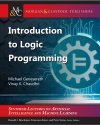Introduction to Logic Programming
Michael Genesereth, Vinay K Chaudhri (2020)

Logic Programming is a style of programming in which programs take the form of sets of sentences in the language of Symbolic Logic. Over the years, there has been growing interest in Logic Programming due to applications in deductive databases, automated worksheets, Enterprise Management (business rules), Computational Law, and General Game Playing.
It begins with the fundamental notion of datasets, i.e., sets of ground atoms. Given this fundamental notion, it then introduces views, i.e., virtual relations; and defines classical logic programs as sets of view definitions, written using traditional Prolog-like notation but with semantics given in terms of datasets rather than implementation. It then introduces actions, i.e., additions and deletions of ground atoms; and defines dynamic logic programs as sets of action definitions.
Michael Genesereth, Vinay K Chaudhri (2020)

Logic Programming is a style of programming in which programs take the form of sets of sentences in the language of Symbolic Logic. Over the years, there has been growing interest in Logic Programming due to applications in deductive databases, automated worksheets, Enterprise Management (business rules), Computational Law, and General Game Playing.
It begins with the fundamental notion of datasets, i.e., sets of ground atoms. Given this fundamental notion, it then introduces views, i.e., virtual relations; and defines classical logic programs as sets of view definitions, written using traditional Prolog-like notation but with semantics given in terms of datasets rather than implementation. It then introduces actions, i.e., additions and deletions of ground atoms; and defines dynamic logic programs as sets of action definitions.
Скрытое содержимое могут видеть только пользователи групп(ы): Premium, Местный, Свои
